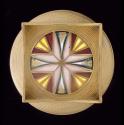Advanced Search
Crosses beaker
Valeri Timofeev (born in 1941)
1995
Object Place: East Stroudsburg, Pennsylvania, United States
Medium/Technique
Plique-a-jour enamel on gilded silver
Dimensions
Overall: 12 x 5.4 x 7.6 cm (4 3/4 x 2 1/8 x 3 in.)
Credit Line
Museum purchase with funds donated by Dr. and Mrs. James Rabb
Accession Number2002.64
NOT ON VIEW
CollectionsContemporary Art, Americas
ClassificationsMetalwork
Enameling on metal dates to the fourth century B.C., when Greek goldsmiths adorned jewelry with cloisonné decoration. Plique-à-jour, the most difficult yet rewarding enameling technique, was not developed until the twelfth century. In this method, the artist uses the capillary action of liquid enamel to fill a fine wire framework. When fired, the enamel becomes a thin, translucent glass coat whose effects resembles those of stained glass.
Latvia-born Valeri Timofeev moved to Moscow, Russia, in 1967 to pursue his artistic education. There, he began work as a metalsmith and enamelist. By 1992 he received national recognition as one of a handful of contemporary artists to show their work at the Kremlin, in conjunction with an exhibition celebrating Faberge’s 150th anniversary.
In 1993 Timofeev immigrated to the United States, where his nationally exhibited work has garnered praise. He has won awards at the Philadelphia Craft Show (1995, 1996, 1998), Washington Craft Show (1997), and Crafts at the Castle in Boston (2001). His work is represented in the Rhode Island School of Design, the Newark Museum, and the Renwick Gallery of the Smithsonian American Art Museum.
Timofeev employs an intricate geometry using cloison wires and color. In this beaker, the primary shape is the square formed by finely spaced cloison wires. Color adds its own pattern of crosses and diamonds, which are painstakingly applied in the form of enamel paste and then kiln fired up to thirty times. The process allows Timofeev to create dense passages of color that define the decorative scheme.
This complex design, a hallmark of Timofeev’s work, recalls the Byzantine and Russian examples that served as his early sources of inspiration. The beaker departs from these early influences with a modern energy, rhythm, and rich coloration for which the artist is renowned.
This text has been adapted from "Silver of the Americas, 1600-2000," edited by Jeannine Falino and Gerald W.R. Ward, published in 2008 by the MFA. Complete references can be found in that publication.
Latvia-born Valeri Timofeev moved to Moscow, Russia, in 1967 to pursue his artistic education. There, he began work as a metalsmith and enamelist. By 1992 he received national recognition as one of a handful of contemporary artists to show their work at the Kremlin, in conjunction with an exhibition celebrating Faberge’s 150th anniversary.
In 1993 Timofeev immigrated to the United States, where his nationally exhibited work has garnered praise. He has won awards at the Philadelphia Craft Show (1995, 1996, 1998), Washington Craft Show (1997), and Crafts at the Castle in Boston (2001). His work is represented in the Rhode Island School of Design, the Newark Museum, and the Renwick Gallery of the Smithsonian American Art Museum.
Timofeev employs an intricate geometry using cloison wires and color. In this beaker, the primary shape is the square formed by finely spaced cloison wires. Color adds its own pattern of crosses and diamonds, which are painstakingly applied in the form of enamel paste and then kiln fired up to thirty times. The process allows Timofeev to create dense passages of color that define the decorative scheme.
This complex design, a hallmark of Timofeev’s work, recalls the Byzantine and Russian examples that served as his early sources of inspiration. The beaker departs from these early influences with a modern energy, rhythm, and rich coloration for which the artist is renowned.
This text has been adapted from "Silver of the Americas, 1600-2000," edited by Jeannine Falino and Gerald W.R. Ward, published in 2008 by the MFA. Complete references can be found in that publication.
DescriptionThe cylindrical vessel is made of plique-à-jour enamel on an 18-karat gilded-silver body. The base is formed from twisted wire that has been wound tightly together at the base; single wires, or cloisons, shaped into decorative patterns, provide the framework for the enamel; the rim is applied. The base is composed of four narrow rectangular silver sheets that form shallow arches along their lengths. Soldered at each end, they form a square and support the base.
Marks
Marked "Vt" within a square on side of base.
InscriptionsNone.
ProvenancePurchased from the artist at the 2001 Crafts at the Castle show in Boston, Massachusetts; named as Director’s Choice for the exhibition.
CopyrightReproduced with permission.





